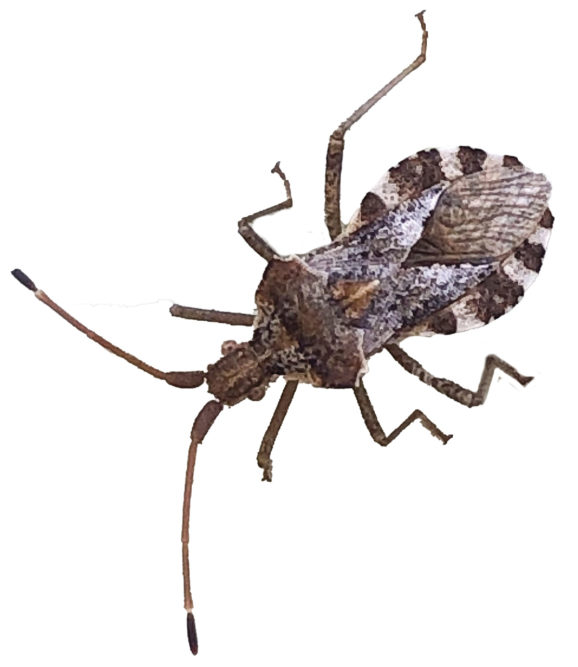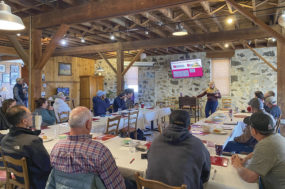During mid-October of 2021, I was finishing up some routine lawn grass management in my backyard in Mountain Home, Idaho, when I stumbled upon a few unique insects I had never seen before. The insects had been congregating and aggregating on the east side of my home residence, possibly searching for sites for overwintering refuge. As a trained entomologist, I knew these insect specimens were something I had never seen before, so I captured a few to take back to my lab for proper pinning, labeling and magnified stereoscopic examination.
With examination and help from Jason Thomas (University of Idaho Extension educator in Minidoka County), we sent a specimen to the College of Agricultural and Life Sciences (CALS) on the University of Idaho main campus and William F. Barr Entomological Museum in Moscow for expert identification and examination by Dr. Luc Leblanc (director, museum curator and taxonomic expert). Leblanc quickly identified this mystery insect as a leaf-footed bug (family: coreidae) but was unable to find any records of these specimens within the William F. Barr Entomological Museum, which houses over a million individual specimens from Idaho’s history.
Leblanc reached out to some regional experts (heteropterans) for further guidance (Dr. David Rider – North Dakota State University, and Dr. Michael Forthman – California Department of Food & Agriculture). They narrowed down the specimen to a particular genus, centrocoris. I then captured several dozen specimens from the Mountain Home area for shipment to Forthman for further examination under magnification and to compare with known specimens from California as well as several published scientific dichotomous keys for species identification. Specimens were dichotomously keyed out and compared to the original descriptor of the species.
The newly invasive insect found in Idaho is Centrocoris volxemi Puton, 1878. C. volxemi is native to the following countries around the world: Iran, Iraq, Russia, Turkey, Turkmenistan, Uzbekistan, Kazakhstan, Saudi Arabia, Korea, China and Indo-China. It was first thought at the time the specimens may have been of the species C. variegatus because this invasive species was first discovered in California in May of 2009. It has become well established in California, where it is now found in the following counties: Alameda, Contra Costa, Santa Clara, Sacramento and Yolo.
Should we be worried?
The process of invasion biology is a multistepped biological, population-based and anthropogenically driven process that involves transportation, introduction, establishment, spread and impact (nuisance and/or pest status). Common routes of transportation for invasive insects may include anything from planes, trains, ships and automobiles. Introduction to the new area (non-native) is the second step in this process; the specimen must survive the transportation process and resume their prospective life cycle (typically very quickly) to establish. Establishment comes about as individuals who have been introduced to a non-native area are able to establish a self-sustaining population; most likely these individuals have found host plants and are able to thrive in the new range. If these individuals desiccate, die or fail to establish, the entire invasion process can come to a screeching halt.
Sometimes invasive species may only establish in certain locations and will not spread to their non-native introduced area. In contrast, if they are able to easily disperse, the newly invasive species may spread over great distances and may impact the local, state, regional or national fauna and become pestiferous, given human perceptions. Non-native invasive organisms may also have negative direct or indirect effects on the economy or the environment, especially if they impact agricultural or horticultural plants and/or products that humans value. If we assume these attributes are synergistic, then the pervasive threat from such an invasive organism may be prominently detrimental to a new area.
C. volxemi was discovered and named in 1878 (Puton) and there have been numerous peer-reviewed scientific journal articles from entomologists and ecologists around its native range. The good news? Most of these peer-reviewed scientific journal articles only just touch on this species, and mentions seem to be present in very minor numbers within these journal articles. It also seems that this species hasn’t been studied in-depth, nor does it seem to be an insect pest of any particular plant of interest to humans, as far as we know.
Of the specimens seen and captured near Mountain Home, they tend to contradict the scientific journal articles, as dozens of specimens have been found to date, most of them aggregating near residential homes. It could be hypothesized that this species might be considered a minor pest insect, as it may be a nuisance home invader to homeowners in Idaho.
At this time, science also does not know the specific host plants associated with C. volxemi, something that should be of concern for all Idahoans. Like all other leaf-footed insects, C. volxemi has piercing-sucking mouthparts, so it is surely feeding upon at minimum one host plant species, possibly more. Given the abundance and variety of plants in southern Idaho, it is of concern to not know what host plant this newly invasive insect is feeding on.
Get involved
If you notice C. volxemi in or around your property during the spring/summer/fall of 2022, please try and document the plant it is found on; this information could be of serious scientific importance, as it could be a host plant of record. C. volxemi is a small brown insect just shorter than half-an-inch in total length with four segmented antennae (with the first being notably thicker than the other segments), mottled brown/white alternating abdomen margins and bronze-colored wings that fold over the abdomen in an “X” pattern (see photo). Information regarding C. volxemi distribution in Idaho and feeding habits/host plants (if you notice any) should be sent to my email address (listed in the author box).








